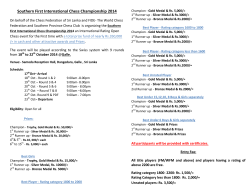
400 Meter
400 Meter Sprinter speed and 800 runner endurance. B. Determine type of 400 runner to be trained. 1. Speed type 200/400 2. Endurance type 400/800 Diminish weaknesses and increase strengths. A. A. B. C. D. Distribute runner’s speed and energies in most efficient manner over the total racing distance. Good pace judgment is vital to good 400 success. Predict potential 400-meter times from a runner’s 200-meter time. Develop endurance versus speed development. Stamina is developed faster in sprinter than speed in 800 runner. A. B. Past approach: 90% anaerobic and 10% aerobic New approach: aerobic training can be as much as 40% A. B. C. Body should gradually be put under stress in training runs. Repeated stress runs over several months will gradually condition the body to handle stress. Moderate runs of 40 seconds will build up lactic acid. A. B. C. D. Off-season Pre-season Early season Late season A. B. C. Pyramid approach Base of aerobic running Movement up the pyramid should be slow A. B. C. D. E. F. G. H. Speed endurance 1. Runner incurs a high oxygen debt. 2. Runs distances of 100-600 meters. Total distance is 2 ½ times racing distance. 3. Rest 5-10 minutes. Tempo endurance: aerobic workout that helps increase oxygen uptake, which helps shorter recovery time. 1. Doing the run slower helps runner learn tempo and rhythm 2.Emphasis is on quantity, not quality. 3. Rest will be short. Strength endurance: activities that last longer than 10 seconds in duration with some type of resistance running – long hills, or stadium steps. Endurance running: pure aerobic running. Runs of 15-45 minutes. Power Speed: speed of muscle contraction is emphasized. Fewer than 10 seconds in duration Event running: runs that teach runner how the 400 should be run. Speed: full speed runs of 30 to 150 meters. Rest is usually long. Strength: general and specific strength development. Traditional weightlifting. Polymeric used as needed. A. B. C. D. Allows runner to do more running which will develop more endurance. Allows runner to take less rest between runs which in turn helps develop more endurance. Protects runner from injury. Stronger will mean faster. A. B. C. D. E. F. G. Continually reloading will keep 400 runner strong, fresh and able to continue to get better. Training is like putting money into bank account, and racing is like writing a check on that account. Runners can’t lose speed if they stay strong. Speed and strength are synonymous. Testing the runner should be done in competition, not practice. Goal should be to run fast at start of season and faster at the end. Treat the season as if it were several mini seasons. Better to be under-trained than over-trained. A. B. Ideal race pattern is -- smooth deceleration -- with as little tightening up at finish as possible Runner should think of the race as 4 different races -- First 100 meters pushed hard. -- Second 100 meters paced to within 1 second of best 200 time. -- Third 100 is positioning so as to be even or even ahead out of the turn. -- Fourth 100 is focused on keeping good technique and trying not to decelerate or tighten up at the finish. A. B. C. D. E. F. G. Quantity to Quality Workouts should follow progressive pattern. Rest should be as short as possible. Stress and lactic acid build up comes only after a moderate run of around 40 seconds. Event runs are very important! Each day’s workouts should help develop a specific area of 400 running. The right 200 pace is vital to success in 400meter running.
© Copyright 2025





















